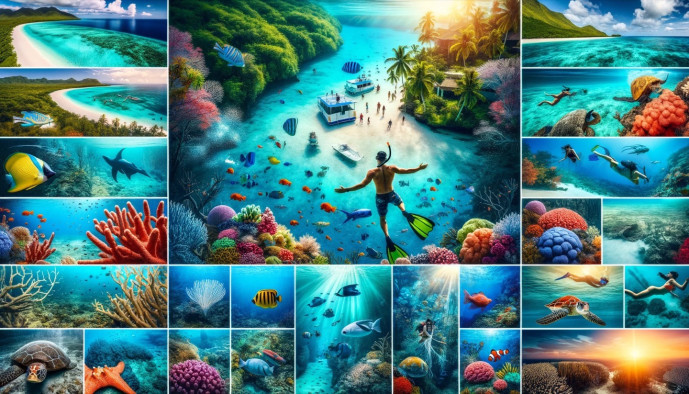Top Snorkeling Spots in Cuba
Dive into Cuba's best snorkeling: Jardines de la Reina to María la Gorda

Essentials
Top Snorkeling Spots by Region
Western Cuba: Near Havana & Viñales
Playa Coral
Location: Between Varadero and Matanzas, easily accessible from the main road.
What Makes It Great: A true “aquarium” experience with direct shore access. The reef starts just a few meters from the beach, making it perfect for all skill levels.
What You’ll See: Over 150 species of fish, brain coral, staghorn coral, and sea fans.
This spot is an excellent and popular day trip from Varadero. There is a small entrance fee which often includes the services of a guide and the rental of basic snorkeling equipment.
María la Gorda
Location: Guanahacabibes Peninsula, Pinar del Río province. This is a remote, protected biosphere reserve.
What Makes It Great: Considered one of the most pristine marine environments in the Caribbean. The visibility is exceptional.
What You’ll See: Black coral gardens (a rarity), sea turtles, and larger fish like grouper and barracuda.
Please note that this destination is best suited for dedicated snorkelers and divers due to its isolation. A visit typically requires an overnight stay at the single hotel and dive resort in the area.
Central Cuba: Bay of Pigs & Northern Cays
Bay of Pigs (Bahía de Cochinos)
Location: South coast of Matanzas province.
What Makes It Great: This area offers a unique combination of sea snorkeling and cenote (flooded cave) swimming. The coast features a steep underwater wall, known as the “drop-off,” very close to shore.
Key Spots:
- Punta Perdiz: Easy entry from a rocky shoreline into calm, clear water teeming with fish.
- Cueva de los Peces: A 70-meter deep cenote filled with fish, located on the inland side of the road. A short walk through a path takes you to the sea on the other side.
Gear can be conveniently rented from small dive centers along the main coastal road. This area is easily visited as a day trip from the nearby towns of Playa Larga or Playa Girón.
Cayo Coco / Cayo Guillermo
Location: Jardines del Rey archipelago, connected to the mainland by a causeway.
What Makes It Great: This is a prime destination for resort-based snorkeling in calm, turquoise waters, making it ideal for families and casual snorkelers.
What You’ll See: Starfish fields, parrotfish, angelfish, and parts of a massive barrier reef system.
The best snorkeling experiences are often accessed via catamaran excursions booked through your hotel, as these trips take you to the richer offshore reef. For shore-based beauty, Playa Pilar on Cayo Guillermo is renowned for its stunning beach and has good snorkeling opportunities nearby.
Eastern Cuba: Holguín & Camagüey
Guardalavaca
Location: North coast of Holguín province.
What Makes It Great: A beautiful resort area with a large, protected coral reef located about one kilometer from the shore.
What You’ll See: A wide variety of hard and soft corals, sponges, and schools of colorful reef fish.
While you can snorkel directly from the beach, the most rewarding experience is a short boat trip out to the main reef. This is a very family-friendly option with calm conditions.
Playa Santa Lucía
Location: North coast of Camagüey province.
What Makes It Great: Home to a 21-kilometer long coral reef, one of the most significant in the Western Hemisphere, which runs parallel to the coast.
What You’ll See: Intact coral formations, diverse marine life, and several shallow shipwrecks accessible to snorkelers.
While the area is famous among advanced divers for its bull shark encounters, be assured that the fantastic and safe snorkeling on the shallow reef occurs far from this site. This region is generally less crowded than other major tourist hubs.
Essential Snorkeling Tips for Your Cuba Trip
Gear: Bring Your Own vs. Renting
- Recommendation: We highly recommend bringing your own mask and snorkel. This ensures a proper, comfortable fit and better hygiene.
- Fins: Fins are bulkier to pack. Rental fins are usually available and adequate for casual snorkeling.
- Rental Availability: Gear is available for rent at all major spots mentioned, either through dive centers, hotels, or beachside shacks. Be aware that the quality can vary.
Safety & Marine Conservation
- Use Reef-Safe Sunscreen: Standard sunscreens contain chemicals that are highly damaging to coral reefs. Please only use mineral-based (zinc oxide, titanium dioxide) sunscreens. A rash guard is an excellent alternative for sun protection.
- Look, Don’t Touch: Never touch, stand on, or kick coral, as it is a living, fragile animal. Do not chase or touch any marine life.
- Know Your Limits: Be aware of water conditions, especially currents. If you are not a strong swimmer, we advise using a snorkel vest for added safety.
Booking Snorkeling Excursions
- How to Book: Tours can be arranged through your hotel’s tour desk, directly with local dive centers, or sometimes through your casa particular host.
- What to Ask: Before booking a boat tour, confirm precisely what is included. Inquire about gear rental, transportation, any park fees, lunch, and drinks, as prices and inclusions can vary significantly.